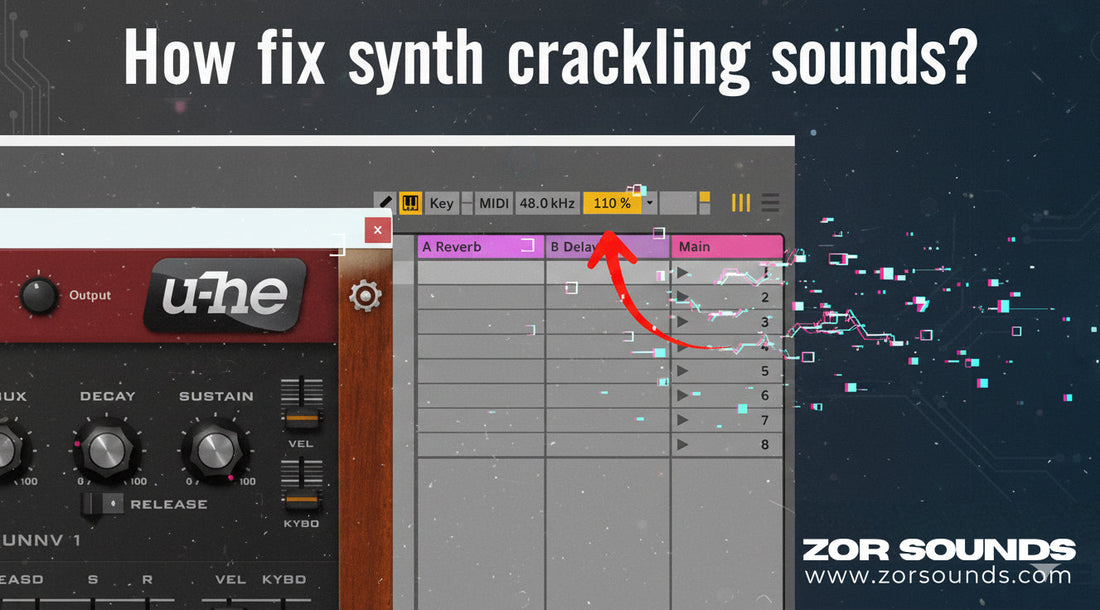
How To Fix Synth Crackling Sounds?
Zor SoundsShare With Friends
Have you ever loaded a lush pad preset that sounded amazing… until your DAW started glitching and your CPU meter spiked red?

In this article, we’ll break down what polyphony actually is, why it causes crackling in synths like Serum 2 and Diva, and how you can optimize your settings to save CPU power without sacrificing sound.
What is Polyphony in a Synth?
Polyphony simply refers to the number of notes or voices your synth can play at the same time. In modern soft synths, each note isn’t just one sound—it can be stacked with multiple layers, unison voices, and effects.
Example: Play one note on a pad with 8-voice unison. That’s already 8 voices.
Play a 4-note chord with the same pad: 8 voices × 4 notes = 32 voices at once.
Add long release tails, reverb, and delay… and your CPU is suddenly juggling dozens of simultaneous sound processes.
This is where the problems start.
Why High Polyphony Eats CPU
Every voice in your synth requires processing power. The more voices you stack, the more your computer has to calculate in real time.
- Layering multiple synths = exponential CPU demand.
- Unison stacking multiplies voice count with each note.
- Release tails keep old notes alive, even after you stop playing.
- Effects like reverb & oversampling amplify the load further.
That’s why you’ll often hear glitching, crackling, or even DAW crashes when working with high-polyphony sounds.
Polyphony and Sound Quality
Polyphony doesn’t just affect performance—it can also change how your mix sounds.
Too many voices can make your mix muddy and lose definition.
Excessive unison can blur transients and reduce punch.
Pads with high release + high unison often swallow other elements of your track.
In other words: more voices ≠ better sound. Sometimes the cleanest, most professional mixes come from reducing polyphony, not increasing it.
How to Manage Polyphony in Popular Synths
Let’s look at how two of the most popular VSTs—u-he Diva and Xfer Serum 2—handle polyphony.
🎛 Diva
Firstly - Turn on the Multicore option on the top right side.
Then, go to the Tuning section. You’ll see options like:
- Mode (poly, mono, legato)
- Accuracy (higher = better sound but heavier CPU)
- Voices (the max number of simultaneous notes)
- Stack (layering voices per note)
Reducing voices and stack will instantly cut CPU load while still giving you a lush sound.

🎛 Serum and Serum 2
Serum also allows you to control max polyphony and unison. Check the Unison option in the Oscillator section. Reducing unison or limiting max voices can make a huge difference in performance. Then go to the voicing section below velocity and note (bottom right) & try to use the optimum amount of voices for your patch. Take a look at the image below.

You can follow the same settings for any synth vst out there. Remember Unison and Voicing. These 2 are the main factors that influence the CPU.
Practical Tips to Reduce CPU Load Without Losing Sound
Here are a few ways to optimize polyphony in your projects:
- Limit max voices in your synth’s settings. If you don’t need 32 voices, don’t allow them.
- Keep basslines mono. Stereo unison on sub-bass is unnecessary and eats headroom.
- Reduce unison. Often 4–6 voices is enough for width.
- Shorten release tails. Pads don’t need 20-second sustains in a mix.
- Freeze or bounce tracks. Once you’re happy with a sound, print it to audio and free CPU space.
These small adjustments will not only stop crackling but also give you a tighter, cleaner mix.
Why Efficient Presets Matter
Most stock or free presets are designed to wow you in solo mode, not to sit cleanly in a mix. That often means heavy unison, long release tails, and high polyphony. They sound huge alone—but overload your project.
At Zor Sounds, we design presets differently:
- -Optimized polyphony for real-world production.
- -CPU-efficient while still delivering big, mix-ready sound.
- -Basses and leads that cut through without needing 20 voices.
So instead of constantly tweaking settings to prevent crackles, you can focus on creating music.
